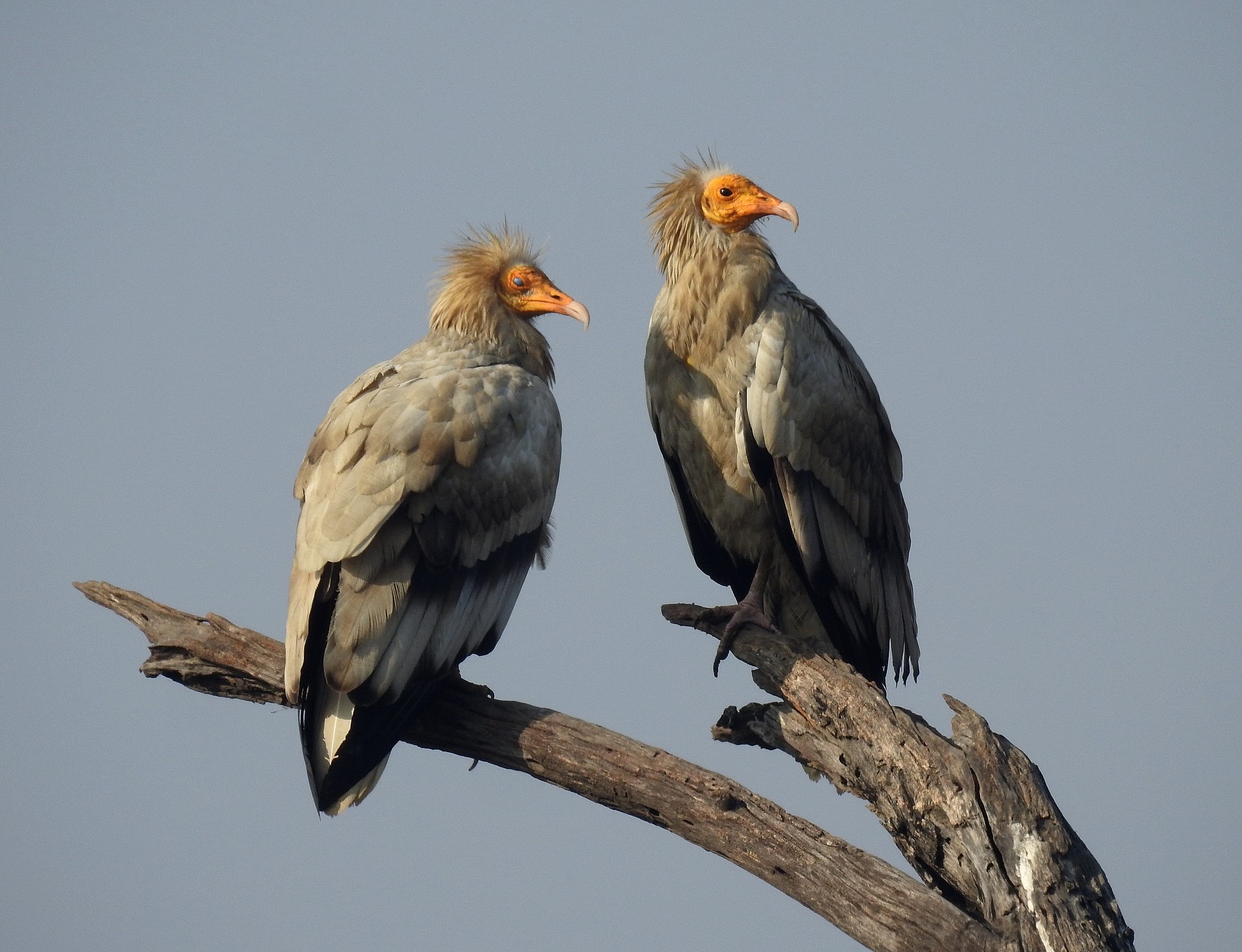
By Koshy Koshy, CC BY 2.0
Etymology: A Childish Trickster
First Described By: Savigny, 1809
Classification: Dinosauromorpha, Dinosauriformes, Dracohors, Dinosauria, Saurischia, Eusaurischia, Theropoda, Neotheropoda, Averostra, Tetanurae, Orionides, Avetheropoda, Coelurosauria, Tyrannoraptora, Maniraptoromorpha, Maniraptoriformes, Maniraptora, Pennaraptora, Paraves, Eumaniraptora, Averaptora, Avialae, Euavialae, Avebrevicauda, Pygostaylia, Ornithothoraces, Euornithes, Ornithuromorpha, Ornithurae, Neornithes, Neognathae, Neoaves, Inopinaves, Telluraves, Afroaves, Accipitrimorphae, Accipitriformes, Accipitridae, Gypaetinae
Status: Extant, Endangered
Time and Place: Since 12,000 years ago, in the Holocene of the Quaternary


Egyptian Vultures are known from locations across India, Western Asia, Africa, and Southern Europe

Physical Description: The Egyptian Vulture is a small vulture, only about 54 to 70 centimeters long with a wingspan of a little more than twice that size. It is also very distinctive in color, and extremely fluffy (which makes sense, given it is probably closely related to the Bearded Vulture). It has a very long and narrow head, which is bare and yellow over the eyes and beak; the tip of the beak is sharply hooked and black. The back of the head and neck is very fluffy and white. The rest of the body is also very puffed, mostly white but with black edges and tips to the wing feathers and tail feathers. It has white fluffy legs, with only some of the feet bear; the feet are pale in color. The females are usually much heavier than the males. The juveniles are significantly darker than the adults in color.
 By Carlos Delgado, CC BY-SA 3.0
By Carlos Delgado, CC BY-SA 3.0
Diet: Egyptian Vultures primarily feed on large dead animals such as carrion of birds, livestock, wild mammals, and even dogs. Usually it will prefer scraps from large carcasses. Sometimes it will also eat eggs!

By Вых Пыхманн, CC By-SA 3.0
Behavior: These vultures are pragmatic opportunists, eating a wide variety of carrion that are often rejected by other vulture. It even competes often with crows and other corvids – more pragmatic, intelligent birds! These vultures spend a lot of the day soaring overhead, searching for food from up to one kilometer away; they also will perch and search for food on trees and cliffs. They tend to congregate in large numbers where there is good sources of food – even though this bird is rare. They will pull off chunks of carcass and often will throw stones at eggs to open them up – a documented use of tools! They also will use twigs to roll up and gather strands of wool for nest-lining. They aren’t very loud birds, making small whistles, grunts, groans, and hisses when needed. Somewhat social birds, they are usually found in pairs or in large groups around carcasses, though often they spend time alone.

By Jiel, CC BY-SA 4.0
Egyptian Vultures breed in the spring, with pairs courting by soaring high together and then swooping and spiraling down. They are monogamous for at least one breeding season, and may stay with the same mate for many years or even their whole lives. They tend to come back to the same nest sites year after year. They make nests out of twigs and wool, placed on cliff ledges and on large tree forks. Neighboring birds may form polyamorous groups with a mated pair, allowing for the two pairs of adults to aid each other in caring for the young. Usually the birds prepare for copulation by giving each other food, and preening each other to get in the “mood”. They lay around two eggs usually, which are incubated for around one and a half months. All adults will incubate the chicks, which are very brown and puffy. They stay in the nest for up to three months, cared for by the parents for most of that time. They reach sexual maturity between 4 and 6 years of age, and can live for nearly four decades, though most tend to die by the fifth year of life in the wild.

By PJeganathan, CC BY-SA 4.0
The vultures tend to soar on thermal wind, using the heat to raise themselves higher in the air; on the land they’re much less graceful, waddling around awkwardly. They are very calculating animals, waiting for predators to leave a carcass before approaching. They’ll even feed on poop to get carotenoids – pigments – from large herbivorous mammals. They tend to migrate only in the northern part of their range – in Africa and India, they stay mainly in the same location year-round. They glide extensively while flying, wasting as little energy while migrating as possible.

By Dr. Raju Kasambe, CC BY-SA 4.0
Ecosystem: Egyptian Vultures prefer open areas, preferably ones with dry and arid habitat. They especially prefer locations near cold and wet climates, such as scrub habitats. They also frequent deserts, steppes, pastures, and some fields, though they try to stay near rocky places when nesting. They also can be found in mountainous regions at lower or mid-level altitudes. They are hunted upon by golden eagles, eagle owls, and red foxes as young; they also are very vulnerable to other mammalian predators (like wolves) as adults and to human interference. In fact, human activity takes a toll on population size.

By Tomasz Baranowski, CC BY 2.0
Other: Egyptian Vultures have gone through extensive population decline, though in some locations the population is more stable now and recovering. They are greatly affected by human activity, including things such as power lines and hunting, intentional poisoning, and superstition-based activity. Since vultures are considered harbingers of doom, people tend to be afraid of them – and they aren’t always the prettiest birds, so people don’t feel emotional attachment to them enough to avoid killing them. Declines in herding and livestock maintenance among humans also has lead to some population decline. Combinations of these factors in many countries make conservation efforts difficult to implement. Some attempts to preserve this vulture have included “vulture restaurants”, where carcasses are made available to vultures nearby.
~ By Meig Dickson
Sources Under the Cut
